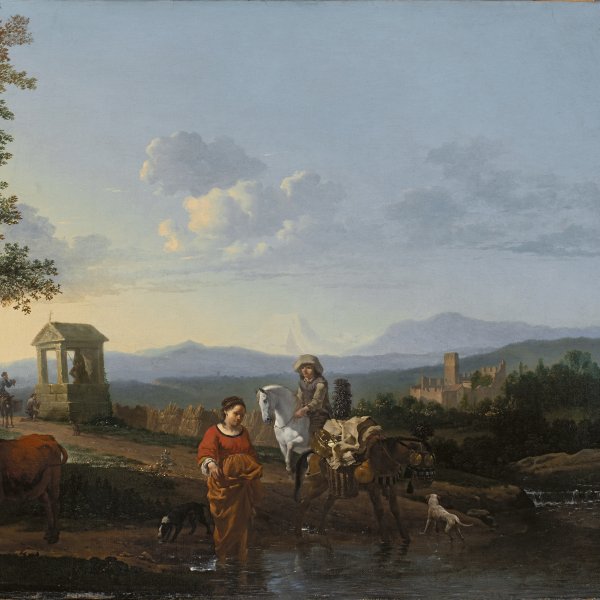Karel Du Jardin
Amsterdam, 1626-Venecia, 1678
Karel du Jardin was probably born around 1622, as his age was given as "about 50" in a document of 1672. It is sometimes assumed that his father was the painter Guillaum de Bardyn of Amsterdam, although there is no confirmation for this. Houbraken states that the artist studied with Claes Berchem. His first dated painting is from 1646 (formerly Cramer, The Hague). Du Jardin travelled from Amsterdam to Paris in 1650 as a merchant and reportedly married Suzanne van Royen in Lyon. Du Jardin may have made an early trip to Italy around 1650-1652, but the evidence is unclear. In any event, he was back in Amsterdam by 1652. Three years later he moved to The Hague, where he is listed as a member of the Confrerie Pictura in 1656-1658. By 1659 he had returned to Amsterdam, where he is documented occasionally between 1670 and 1674. Ferdinand Bol portrayed the artist in 1658, although the painting is now known only through an 18th century drawing.
In 1653 he published a series of prints and continued to make etchings through the 1650s. The following decade Du Jardin began to paint religious and history works with large figures. In May 1672 Du Jardin, along with several other Amsterdam artists, was asked to appraise Italian pictures from the Reynst Collection.
In 1675 Du Jardin sailed to Italy with Jan Reynst, probably stopping in Tangiers in October 1675. A painting in Antwerp (Koninklijk Museum voor Schone Kunsten, inv. no. 965) signed "Roma 1675" initiated a period of renewed activity in landscape painting. His nickname in Rome was "Bokkebaert" (Goatee). He died in Venice in 1678.
A versatile artist, Du Jardin painted religious and history paintings, genre scenes, animal pieces, and portraits, as well as Italianate landscapes.
Peter C. Sutton
In 1653 he published a series of prints and continued to make etchings through the 1650s. The following decade Du Jardin began to paint religious and history works with large figures. In May 1672 Du Jardin, along with several other Amsterdam artists, was asked to appraise Italian pictures from the Reynst Collection.
In 1675 Du Jardin sailed to Italy with Jan Reynst, probably stopping in Tangiers in October 1675. A painting in Antwerp (Koninklijk Museum voor Schone Kunsten, inv. no. 965) signed "Roma 1675" initiated a period of renewed activity in landscape painting. His nickname in Rome was "Bokkebaert" (Goatee). He died in Venice in 1678.
A versatile artist, Du Jardin painted religious and history paintings, genre scenes, animal pieces, and portraits, as well as Italianate landscapes.
Peter C. Sutton





